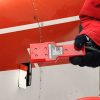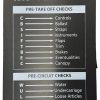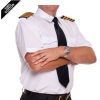The significance of specialized tools and devices in pilot training cannot be overstated, as they provide trainee pilots with invaluable hands-on experience, realistic simulations, and crucial knowledge that is essential for safe and effective flight operations. Without access to high-quality training equipment, pilots would lack the necessary skills and confidence to navigate the skies with precision and proficiency.
Brief Overview of the Importance of Light Aircraft Training Equipment
Light aircraft training equipment encompasses a wide array of tools specifically designed to replicate real-world flying conditions in a controlled environment. From flight simulators to cockpit trainers, this equipment serves as a bridge between theoretical knowledge and practical application for individuals pursuing a career in aviation.
By immersing trainee pilots in simulated scenarios that mimic actual flight conditions, these training devices help cultivate essential skills such as decision-making, situational awareness, and emergency response. Moreover, light aircraft training equipment is instrumental in familiarizing aspiring aviators with the complex systems and components found within modern aircraft.
Through hands-on practice using specialized tools like avionics simulators and engine maintenance trainers, pilots-in-training develop a deep understanding of aviation technology and gain proficiency in operating critical aircraft systems. This familiarity not only enhances safety during flight operations but also instills confidence in pilots when faced with challenging situations or unforeseen emergencies.
Flight Simulators: Enhancing Pilot Training with Virtual Reality
Flight simulators serve as invaluable tools in the realm of pilot training, offering a dynamic and immersive environment for trainee pilots to hone their skills. These advanced systems simulate real-world flight scenarios with remarkable accuracy, allowing students to experience diverse weather conditions, challenging terrains, and complex aircraft operations in a controlled setting.
By replicating the sensation of flying an actual aircraft, simulators provide a safe yet realistic platform for aspiring pilots to practice maneuvers, navigation techniques, and emergency procedures. There are various types of flight simulators utilized in light aircraft training programs, each catering to specific learning objectives and skill development.
Full-flight simulators (FFS) stand out as the most sophisticated option, featuring detailed cockpit replicas, motion platforms for realistic movement simulation, and high-fidelity visuals that closely mimic real-world environments. Flight training devices (FTDs), on the other hand, offer cost-effective solutions for procedural training and cockpit familiarization by focusing on specific aspects of flight operations.
Additionally, desktop simulators provide accessible options for supplementary practice sessions at home or in classroom settings. The benefits of incorporating flight simulators into pilot education are multifaceted.
Not only do these systems offer a safe environment for trainees to make mistakes and learn from them without risking lives or resources, but they also enable instructors to tailor scenarios according to individual learning needs. Furthermore, by providing repetitive practice opportunities without the constraints of actual flight time costs or environmental factors like weather conditions, simulators contribute significantly to skill retention and proficiency enhancement among aspiring aviators.
Cockpit Trainers: Bridging Theory with Hands-On Experience
Cockpit trainers play a pivotal role in introducing trainee pilots to the intricacies of aircraft controls and instrumentation within a simulated cockpit environment. Designed to replicate the layout and functionality of actual aircraft cockpits, these specialized trainers offer students hands-on experience with essential controls such as yokes, pedals, throttle levers, switches, and navigation displays. By familiarizing learners with cockpit ergonomics and instrument operation early in their training journey, trainers facilitate a seamless transition from theoretical knowledge acquisition to practical application in real-flight situations.
The purpose of cockpit trainers extends beyond mere familiarity with cockpit layout; they serve as interactive learning platforms where students can practice pre-flight checks, instrument scanning techniques, checklist procedures, communication protocols with air traffic control (ATC), and emergency response drills. Through realistic simulation capabilities that mimic cabin vibrations during engine start-up or turbulence effects during flight maneuvers, trainers prepare pilots for the sensory experiences they will encounter when operating actual light aircraft.
This hands-on exposure builds confidence and muscle memory crucial for effective decision-making under pressure situations. Moreover,
Avionics Training Tools
Avionics training tools play a critical role in shaping the knowledge and skills of aspiring pilots, particularly in understanding complex systems like radar, GPS navigation, and communication equipment. Radar systems simulators allow trainee pilots to grasp the principles of aircraft surveillance, target tracking, and weather detection. By using radar simulation software, students can practice interpreting radar displays and reacting to various scenarios, enhancing their situational awareness in the air.
GPS navigation simulators are invaluable tools for teaching trainee pilots how to plan routes, navigate airspace efficiently, and utilize GPS technology for precision flying. These simulators replicate real-world GPS interfaces and scenarios, enabling students to practice waypoint navigation, instrument approaches, and flight management system programming.
By mastering GPS navigation through simulation training, pilots develop the confidence and competence required for safe and precise aerial navigation. Communication equipment trainers focus on honing trainee pilots’ ability to effectively communicate with air traffic control (ATC), fellow crew members, and other aircraft.
Through simulated radio communications exercises using specialized software or mock cockpit setups, students learn proper phraseology protocols, emergency procedures communication techniques, and radio frequency management skills. Effective use of communication equipment is vital for ensuring clear and concise interactions in the busy airspace environment.
Advanced Avionics Simulators
In modern light aircraft training programs, advanced avionics simulators are at the forefront of immersive learning experiences for aspiring pilots. These simulators replicate sophisticated avionics systems found in contemporary aircraft models with remarkable accuracy. Trainees can interact with glass cockpit displays featuring multifunctional displays (MFDs), primary flight displays (PFDs), autopilot systems, and integrated avionics suites.
The significance of advanced avionics simulators lies in their ability to expose trainee pilots to cutting-edge cockpit technology that they will encounter during their careers as commercial or private pilots. By navigating through realistic flight scenarios using these simulators’ electronic flight instruments (EFIS) and avionics interfaces, students gain hands-on experience with modern aviation electronics without leaving the safety of a ground-based training environment.
Mission-specific simulations such as IFR procedures training or cross-country navigation challenges can be seamlessly integrated into these advanced avionics simulators to provide a comprehensive learning platform for pilot candidates. The combination of realistic visuals, accurate system responses, and interactive scenario-based training exercises makes these simulators indispensable tools for developing proficient aviators capable of handling diverse flying conditions with confidence.
Portable Flight Planning Tools: Enhancing Pilot Preparedness
Electronic Flight Bags (EFBs), aviation apps, and digital chart subscriptions have revolutionized the way pilots plan and execute flights. These portable tools provide convenient access to crucial flight information, such as weather updates, navigational charts, airport directories, and flight planning software.
During pilot training, the integration of EFBs and aviation apps allows trainees to familiarize themselves with real-time data management and decision-making processes in a simulated environment. The efficiency of these tools in organizing flight plans, calculating fuel requirements, and accessing up-to-date information significantly enhances pilot preparedness for diverse flying scenarios.
Modern aviation education has embraced technology through the utilization of EFBs and aviation apps to streamline flight planning procedures. Trainee pilots can benefit from hands-on experience with these tools to optimize route planning, monitor weather patterns, and conduct pre-flight checks efficiently.
The interactive nature of electronic flight planning tools enables students to practice decision-making skills under varying conditions, preparing them for the dynamic challenges they may face during actual flights. By immersing themselves in virtual scenarios facilitated by EFBs and aviation apps, aspiring pilots can hone their ability to adapt swiftly to changing circumstances while maintaining a high level of situational awareness.
Emergency Procedures Trainers: Simulating Critical Scenarios
The use of crash simulation devices, fire extinguisher practice kits, and emergency evacuation drills in pilot training plays a pivotal role in enhancing trainee pilots’ response capabilities during critical situations. These specialized equipment simulate realistic emergency scenarios that challenge students to apply their knowledge of safety procedures effectively under pressure.
By incorporating hands-on exercises with crash simulation devices that mimic aircraft emergencies or fire extinguisher practice kits that simulate onboard fires, aspiring pilots develop essential skills in crisis management and rapid decision-making. Analysis of specialized equipment used for simulating emergency scenarios reveals the comprehensive approach taken in pilot training programs to prepare students for unexpected incidents while airborne or on the ground.
Through immersive simulations facilitated by emergency procedures trainers, trainee pilots learn how to react swiftly and decisively when faced with challenging circumstances such as engine failures or cabin decompression events. By emphasizing practical experience alongside theoretical knowledge acquisition, these training devices instill confidence in students’ ability to handle emergencies competently, fostering a culture of safety-conscious aviators dedicated to mitigating risks effectively.
Conclusion
Embracing Innovation in Light Aircraft Training Equipment
In the realm of aviation education, the evolution of light aircraft training equipment stands as a testament to the industry’s commitment to innovation and excellence. The integration of cutting-edge technologies like avionics simulators and engine maintenance trainers has revolutionized how aspiring pilots acquire essential skills and knowledge. By embracing these advancements, training programs can offer immersive, hands-on experiences that prepare pilots for real-world challenges with unprecedented precision.
Furthermore, the utilization of portable flight planning tools and emergency procedures trainers underscores the adaptability of modern aviation education to meet the demands of a dynamic industry. The convenience and efficiency afforded by tools such as electronic flight bags and crash simulation devices not only enhance training effectiveness but also instill a sense of preparedness in trainee pilots.
By equipping future aviators with comprehensive resources and practical experiences, the aviation community fosters a culture of safety, resilience, and continuous learning. As we navigate through an era defined by technological progress and rapid advancements in aviation, the significance of robust light aircraft training equipment cannot be understated.
This sophisticated array of tools not only empowers trainee pilots to master complex systems but also cultivates a mindset of constant improvement and adaptability in the face of challenges. By investing in innovative training solutions, we uphold a tradition of excellence in aviation education while propelling aspiring aviators towards successful careers filled with boundless opportunities for growth and achievement.













